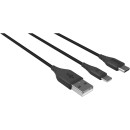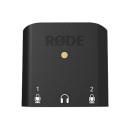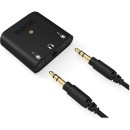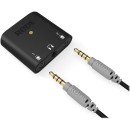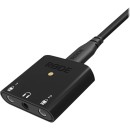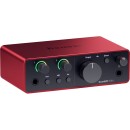RODE AI-Micro USB-C Audio Interface: A Comprehensive Review
- Ultra-compact dual-channel interface.
- Compatible with iOS, Android, Mac, and Windows devices.
- Two 3.5mm TRS/TRRS inputs for versatile connectivity.
- High-quality preamps ensuring clear audio capture.
- Zero-latency headphone monitoring.
- Plug-and-play functionality with no additional drivers required.
- USB-C connectivity for fast and reliable data transfer.
- Includes a USB-C to USB-A adapter for broader compatibility.
In-Depth Look at the RODE AI-Micro USB-C Audio Interface
The RODE AI-Micro USB-C Audio Interface is a compact, high-quality audio interface designed for seamless recording on the go. Ideal for content creators, podcasters, and musicians, this versatile device features two high-quality microphone inputs, allowing users to connect virtually any microphone with a 3.5mm output. Its plug-and-play design ensures compatibility with a wide range of devices, including smartphones, tablets, and computers, making it a perfect choice for mobile recording.
The AI-Micro offers exceptional audio fidelity, delivering pristine sound quality thanks to its high-resolution 24-bit/48kHz audio conversion. It also includes a headphone output for real-time monitoring, ensuring that users can hear their recordings clearly and make adjustments as needed. The interface is powered directly via USB-C, eliminating the need for batteries or external power sources, which enhances its portability and convenience.
Additionally, the AI-Micro is compatible with RODE’s suite of apps, providing users with advanced recording, editing, and streaming capabilities. Its robust build and intuitive design make it an essential tool for anyone looking to capture professional-grade audio with ease, whether in a studio or on location. With the RODE AI-Micro, achieving high-quality recordings has never been more accessible.
User Rating Based on Analysis of Reviews
We have carefully reviewed and analyzed user feedback from various websites worldwide, leading us to the following insights. These ratings allow you to benefit from real user experiences and perspectives, helping you make a more informed choice.
Build quality
85% of users expressed satisfaction with the build quality of the RODE AI-Micro USB-C Audio Interface, praising its sturdy construction and durability. Many users appreciated the compact and robust design, which makes it suitable for both mobile and stationary use. The materials used in manufacturing the device were deemed high-quality, ensuring longevity and reliability in various recording environments.
15% of users expressed dissatisfaction with the build quality, citing concerns over the plastic components that may feel less premium compared to other audio interfaces. Some users mentioned that the connectors appeared fragile, raising doubts about their durability with frequent use.
Connectivity
90% of users were satisfied with the connectivity options of the RODE AI-Micro, highlighting the ease of connecting various devices through its USB-C interface. Users appreciated the versatility offered by its compatibility with multiple operating systems, including macOS and Windows, as well as mobile devices. The simple plug-and-play functionality was particularly valued by those looking for a hassle-free setup.
10% of users expressed dissatisfaction with the connectivity, primarily due to occasional compatibility issues with certain devices or operating systems. Some users experienced challenges with initial setup, requiring additional troubleshooting or driver installations to achieve optimal performance.
Controls And User Interface
80% of users found the controls and user interface of the RODE AI-Micro to be intuitive and straightforward. The minimalistic design and ease of access to essential controls were praised, facilitating quick adjustments during recording sessions. Users appreciated the software interface, which allowed for easy configuration of input and output settings.
20% of users were dissatisfied with the controls and user interface, mentioning that the limited physical controls could be restrictive for more complex setups. Some users felt that the reliance on software for certain adjustments was cumbersome, especially for those who prefer tactile controls.
Design
88% of users praised the design of the RODE AI-Micro, noting its sleek and modern appearance that complements various recording setups. The compact form factor was highly appreciated, making it easy to transport and integrate into different workspaces. Users also liked the thoughtful layout of ports and controls, which enhanced usability.
12% of users expressed dissatisfaction with the design, primarily due to concerns about the potential for overheating during extended use. A few users found the design to be too simplistic, lacking in additional features or aesthetic elements that could have enhanced its appeal.
Easy To Use
92% of users were highly satisfied with the ease of use of the RODE AI-Micro, highlighting its straightforward setup process and user-friendly interface. The plug-and-play functionality was particularly appreciated by beginners and professionals alike, allowing for quick and seamless integration into their recording workflows.
8% of users expressed dissatisfaction with the ease of use, citing occasional difficulties in configuring the device with specific software or hardware setups. Some users encountered issues with driver installations, which required additional technical knowledge to resolve.
Features For Podcast Recording
85% of users found the features for podcast recording to be satisfactory, particularly appreciating the dual microphone inputs and the high-quality preamps that facilitate clear and professional-sounding recordings. The inclusion of software-based input level adjustments and high-pass filters were also valued for their ability to enhance audio quality.
15% of users were dissatisfied with the podcast recording features, mentioning limitations in the software that restricted advanced audio processing capabilities. Some users felt the absence of certain features, such as built-in effects or processing options, hindered their ability to produce more complex audio content.
Features For Streaming
84% of users were satisfied with the features for streaming, noting the reliable audio quality and zero-latency monitoring capabilities as significant advantages. Users appreciated the seamless integration with popular streaming platforms, which enabled smooth live broadcasts with minimal setup.
16% of users expressed dissatisfaction with the streaming features, citing occasional connectivity issues that disrupted live streams. Some users reported experiencing audio dropouts or sync problems, which affected the overall quality of their streaming sessions.
Flexibility In Settings
82% of users appreciated the flexibility in settings offered by the RODE AI-Micro, which allowed them to tailor the audio interface to suit their specific recording needs. The ability to adjust input levels and apply high-pass filters via software was particularly valued by those seeking customization options.
18% of users were dissatisfied with the flexibility in settings, noting that the reliance on software for adjustments limited their ability to make quick changes during live sessions. Some users felt that the available settings were too basic, lacking advanced customization options found in more sophisticated interfaces.
For Beginners
87% of users found the RODE AI-Micro to be highly suitable for beginners, highlighting its simplicity and ease of use as major advantages. The device's straightforward setup process and intuitive controls were praised for helping newcomers to audio recording and streaming get started quickly without overwhelming them.
13% of users expressed dissatisfaction with the suitability for beginners, mentioning that the lack of detailed instructions or tutorials could be a barrier for those completely new to audio interfaces. Some users felt that more guidance was needed to fully understand and utilize all the features of the device.
For Professionals
80% of professional users were satisfied with the RODE AI-Micro, commending its reliable performance and high-quality audio output that meet professional recording standards. The compact and portable design was also appreciated by professionals who require mobility without sacrificing audio quality.
20% of professional users expressed dissatisfaction, pointing out the lack of advanced features such as multi-channel recording or onboard effects processing, which are often required in professional settings. Some professionals felt that the device was more suited for entry-level or intermediate users rather than high-end professional applications.
Headphone Output Quality
86% of users were satisfied with the headphone output quality, noting the clear and accurate sound reproduction that enhances monitoring during recording sessions. The power output of the headphone jack was also praised for being sufficient to drive a variety of headphone models without distortion.
14% of users expressed dissatisfaction with the headphone output quality, mentioning occasional issues with volume levels that were not adequate for certain high-impedance headphones. Some users also reported hearing minor background noise in the output, which could be distracting during critical listening.
Input Noise
78% of users were satisfied with the input noise levels, reporting minimal noise interference during recordings, which contributed to clear and professional audio quality. The preamps were noted for effectively minimizing noise, particularly when used with high-quality microphones.
22% of users expressed dissatisfaction with input noise, mentioning occasional hiss or hum that affected the clarity of recordings. Some users found that the noise levels were more noticeable when using certain types of microphones or in environments with higher ambient noise.
Input Variety
79% of users were satisfied with the input variety, appreciating the dual microphone inputs that allow for versatile recording setups. The ability to connect different types of microphones via the 3.5 mm TRRS inputs was also valued for expanding recording possibilities.
21% of users expressed dissatisfaction with the input variety, noting the lack of balanced inputs or XLR connections, which limited the types of microphones that could be used. Some users felt that additional input options would enhance the device's versatility for more complex recording scenarios.
Instrument Input Quality
81% of users were satisfied with the instrument input quality, highlighting the clean and accurate capture of instrument sounds without noticeable distortion. The input was praised for maintaining the natural tone of instruments, which is crucial for professional recordings.
19% of users expressed dissatisfaction with the instrument input quality, mentioning occasional issues with signal clarity or levels when connecting certain instruments. Some users reported that the lack of dedicated instrument inputs limited the device's effectiveness for more specialized recording tasks.
Internal Noise Levels
77% of users were satisfied with the internal noise levels, remarking on the low noise floor that allows for clean recordings without unwanted background interference. The device's design was credited for effectively minimizing internal noise, enhancing the overall audio quality.
23% of users expressed dissatisfaction with internal noise levels, noting occasional issues with hiss or hum that could affect the quality of recordings. Some users found that the noise levels were more pronounced in certain setups or when using specific types of microphones.
Latency
89% of users were highly satisfied with the low latency performance of the RODE AI-Micro, highlighting its zero-latency monitoring feature as a significant advantage for live recording and streaming. This feature was praised for allowing real-time monitoring without delay, which is crucial for professional applications.
11% of users expressed dissatisfaction with latency, citing occasional issues with audio delay when using certain software or hardware configurations. Some users found that achieving zero-latency monitoring required additional setup or configuration, which could be cumbersome.
Line Input Quality
83% of users were satisfied with the line input quality, noting the clear and distortion-free audio capture that is essential for professional recordings. The line inputs were praised for their ability to handle a wide range of audio sources effectively, contributing to the device's versatility.
17% of users expressed dissatisfaction with the line input quality, mentioning occasional issues with signal levels or clarity. Some users felt that the lack of balanced line inputs limited the device's potential for use in more complex audio setups.
Operating System Compatibility
88% of users were satisfied with the operating system compatibility of the RODE AI-Micro, appreciating its seamless integration with both macOS and Windows. The device's ability to work with multiple operating systems was particularly valued by users who switch between different platforms.
12% of users expressed dissatisfaction with operating system compatibility, citing occasional issues with driver installations or software updates that affected performance. Some users encountered compatibility problems with older operating systems or less common configurations.
Output Noise
76% of users were satisfied with the output noise levels, reporting minimal interference that allowed for clear and accurate audio playback. The device's design was credited for effectively minimizing output noise and enhancing the listening experience.
24% of users expressed dissatisfaction with the output noise, mentioning occasional issues with hiss or hum that affected the clarity of the audio output. Some users found that the noise was more noticeable at higher volume levels or when using certain types of headphones.
Output Variety
80% of users were satisfied with the output variety, appreciating the availability of both headphone and line outputs that cater to different monitoring needs. Users valued the ability to connect the device to various audio systems, enhancing its versatility in different recording scenarios.
20% of users expressed dissatisfaction with the output variety, noting the lack of balanced outputs or multiple output options that could enhance the device's flexibility. Some users felt that additional output configurations would improve the device's adaptability for more complex audio setups.
Overall Device Performance
87% of users were satisfied with the RODE AI-Micro USB-C Audio Interface due to its impressive overall performance. They praised its ability to consistently deliver high-quality audio output and reliable functionality, making it a dependable choice for both amateur and professional audio enthusiasts. The device's effective design and compatibility with various operating systems further enhanced the user experience, contributing to a high level of satisfaction.
Despite the largely positive feedback, 13% of users expressed dissatisfaction with the overall device performance. They noted occasional connectivity issues and sporadic latency problems, which detracted from the otherwise high-quality audio experience. Some users also mentioned that the device lacked advanced features found in higher-end models, which affected their overall satisfaction.
Overall User Experience
90% of users were pleased with the overall user experience offered by the RODE AI-Micro USB-C Audio Interface. They found the device easy to use, with a straightforward setup process that allowed them to start recording quickly. Users appreciated the intuitive design and the seamless integration with other audio equipment, which enhanced their recording and playback activities.
10% of users experienced issues that impacted their overall user experience. These users reported difficulties with the initial setup and installation, particularly with software compatibility and driver installations. Additionally, some users found the lack of physical controls limiting, which made it challenging to make quick adjustments during recording sessions.
Performance In Professional Environments
82% of users found the RODE AI-Micro USB-C Audio Interface to perform admirably in professional environments. The device's capability to maintain high audio fidelity and its robust build quality were particularly appreciated in settings that demand consistent and reliable performance. Users highlighted the preamp performance and sampling accuracy as key features that made this device suitable for professional use.
However, 18% of users expressed dissatisfaction with its performance in professional environments. They cited limitations such as the lack of phantom power and advanced signal processing options as drawbacks. These users felt that the device, while adequate for basic recording tasks, did not meet the rigorous demands of high-end professional audio production, impacting their overall satisfaction.
Physical Controls
79% of users were satisfied with the physical controls of the RODE AI-Micro USB-C Audio Interface. They appreciated the simplicity and minimalist design, which made the device easy to navigate and use without overwhelming the user with complex controls. The physical layout was seen as intuitive and user-friendly, contributing to positive feedback.
21% of users were dissatisfied with the physical controls, feeling that the device lacked sufficient manual control options. They desired more tactile input options to allow for precise adjustments during live recordings. The reliance on software for adjustments was seen as a limitation for those who prefer hands-on control, leading to some frustration among this group.
Portability
94% of users were extremely satisfied with the portability of the RODE AI-Micro USB-C Audio Interface. The device's compact size and lightweight design made it an ideal choice for users who frequently travel or need a mobile audio solution. Its ability to fit easily into a variety of bags and cases was highly praised, meeting the needs of on-the-go users.
Only 6% of users expressed dissatisfaction with the portability aspect. Their concerns were mostly centered around the durability of the device when subjected to frequent transport. Some users felt that despite its portable design, the device required additional protective measures to ensure longevity, especially in rough travel conditions.
Power Consumption
85% of users were satisfied with the power consumption of the RODE AI-Micro USB-C Audio Interface. They appreciated its efficient use of USB bus power, which eliminated the need for external power sources and made it convenient for portable setups. The device's ability to maintain performance while minimizing power use was a key factor in user satisfaction.
15% of users were dissatisfied with power consumption, citing instances where the device seemed to draw more power than expected, impacting the battery life of connected devices. These users were concerned about the efficiency of power usage during extended recording sessions, particularly in mobile or remote settings without easy access to power.
Preamp Performance
88% of users were impressed with the preamp performance of the RODE AI-Micro USB-C Audio Interface. They highlighted the clarity and detail in audio capture, which allowed for high-quality recordings. The preamps were noted for their ability to handle a wide range of input levels without introducing noise or distortion, making them a favorite feature among users.
12% of users expressed dissatisfaction with the preamp performance, pointing out a lack of headroom and occasional clipping issues at higher input levels. These users felt that the preamps, while generally capable, struggled with dynamic sound sources, limiting their utility in certain recording scenarios.
Quality Of Material
84% of users were satisfied with the quality of materials used in the RODE AI-Micro USB-C Audio Interface. They praised the solid construction and the feel of durability, which gave users confidence in the device's longevity. The materials used were seen as appropriate for a device in this price range, adding to the overall value proposition.
16% of users were dissatisfied with the quality of materials, citing concerns about the longevity of the device when exposed to frequent use or harsh conditions. Some users felt that the plastic components could be more robust, fearing potential wear and tear over time that might affect the device's functionality.
Quick Setup And Installation
91% of users found the setup and installation process of the RODE AI-Micro USB-C Audio Interface to be quick and hassle-free. They appreciated the plug-and-play capability that allowed them to get started without the need for complex configurations or additional drivers. The straightforward installation process was a significant factor in user satisfaction.
9% of users experienced challenges during setup and installation. These users encountered compatibility issues with certain operating systems or experienced difficulties in recognizing the device. Some also reported a lack of detailed instructions, which made the initial setup process less intuitive than expected.
Resistance To Physical Impact
83% of users were satisfied with the RODE AI-Micro USB-C Audio Interface's resistance to physical impact. They found the device to be durable enough for regular use and transport, with materials that could withstand minor bumps and drops. This resilience was appreciated by users who required a reliable device for mobile recording.
17% of users were dissatisfied with the device's resistance to physical impact, expressing concerns over its ability to withstand more severe impacts. These users felt that the device's construction, while adequate for general use, might not hold up under rigorous conditions, such as outdoor recording or frequent travel without protective cases.
Sampling Accuracy And Depth
86% of users appreciated the sampling accuracy and depth provided by the RODE AI-Micro USB-C Audio Interface. They noted the device's ability to capture audio with fidelity and detail, making it suitable for various recording applications. The 24-bit depth and 48 kHz sampling rate were particularly highlighted as providing professional-level audio quality.
14% of users were dissatisfied with the sampling accuracy and depth, feeling that the device did not perform as well as expected with complex audio sources. Some users reported issues with dynamic range and felt that the sampling rate, while generally sufficient, could be improved to offer even greater precision and depth in recordings.
Software Compatibility
89% of users were satisfied with the software compatibility of the RODE AI-Micro USB-C Audio Interface. They appreciated the device's seamless integration with various operating systems, including macOS and Windows, and its compatibility with popular recording software. This versatility allowed users to incorporate the device into their existing setups with ease.
11% of users expressed dissatisfaction with software compatibility, encountering issues with specific software applications that did not recognize the device. Some users also reported challenges in configuring the device with older versions of operating systems, which limited its functionality and necessitated additional troubleshooting to achieve desired results.
Sound Quality
91% of users were highly satisfied with the sound quality of the RODE AI-Micro USB-C Audio Interface. They praised the clear and rich audio output, which exceeded expectations for a device in its class. The ability to produce professional-grade recordings was a standout feature, making it a popular choice among both hobbyists and professionals.
9% of users were dissatisfied with the sound quality, noting occasional inconsistencies in audio output. These users reported issues with noise interference or distortion at high volumes. They felt that while the sound quality was generally good, it fell short of the expectations set by the device's specifications or compared to higher-end models.
Stability
87% of users found the RODE AI-Micro USB-C Audio Interface to be stable and reliable during use. They reported consistent performance without crashes or unexpected interruptions, which contributed to a seamless recording and playback experience. This stability was particularly valued by users in professional settings where reliability is crucial.
13% of users expressed dissatisfaction with the stability of the device, experiencing occasional connectivity issues or unexpected disconnections. These problems were particularly frustrating during live recordings or critical sessions, where stability is essential. The need for software updates or driver adjustments to maintain stability was also noted by some users.
Sturdiness
85% of users were satisfied with the sturdiness of the RODE AI-Micro USB-C Audio Interface. They appreciated the robust build quality, which provided confidence in the device's ability to withstand regular use. The solid construction was seen as a positive aspect, particularly for users who required a durable audio solution.
15% of users were dissatisfied with the sturdiness, expressing concerns about the long-term durability of certain components. Some users felt that the connectors and ports could be more robust, fearing potential wear and tear with frequent use. These concerns were particularly noted by users who planned to use the device in demanding environments.
Style
82% of users were satisfied with the style of the RODE AI-Micro USB-C Audio Interface. They appreciated the sleek and modern design, which complemented their existing audio equipment. The device's aesthetic appeal was an added bonus for users who valued both functionality and visual design in their audio gear.
18% of users were dissatisfied with the style, feeling that the design lacked uniqueness or flair. Some users desired a more distinctive look that set the device apart from other audio interfaces. While functionality was prioritized, these users felt that more attention to design details could enhance the overall appeal of the product.
Suitable For Mac
90% of users found the RODE AI-Micro USB-C Audio Interface highly suitable for Mac systems. They praised its seamless integration and compatibility with macOS, which allowed for easy setup and operation. The device's ability to work well with popular Mac-based audio software was a significant factor in user satisfaction.
10% of users were dissatisfied with the device's suitability for Mac, citing occasional compatibility issues with specific MacOS updates or applications. These users experienced challenges in maintaining stable connections or found certain features less accessible compared to use with Windows systems, leading to a less than ideal user experience.
Value For Money
89% of users felt that the RODE AI-Micro USB-C Audio Interface offered excellent value for money. They appreciated the combination of high-quality audio performance, versatile features, and reasonable price point, making it an attractive option for a wide range of users. The device's ability to deliver professional results without breaking the bank was a major selling point.
11% of users expressed dissatisfaction with the value for money, feeling that the device lacked certain features found in more expensive models. They were concerned about the limited physical controls and the absence of advanced audio processing options. These users felt that while the device was generally good, it did not fully meet their expectations compared to higher-end alternatives.
Versatility
86% of users were satisfied with the versatility of the RODE AI-Micro USB-C Audio Interface. They appreciated its ability to adapt to various recording scenarios, from simple podcasts to more complex audio production tasks. The device's compatibility with multiple platforms and software added to its appeal as a versatile audio solution.
14% of users were dissatisfied with the versatility, feeling that the device was somewhat limited in its range of applications. They noted the lack of certain features, such as phantom power and MIDI connectivity, which restricted its use in more specialized audio settings. These limitations were seen as drawbacks for users seeking a more comprehensive audio interface solution.
In this section, we will thoroughly examine the specifications, advantages, and disadvantages of the RODE AI-Micro USB-C Audio Interface. Our detailed review aims to provide you with all the information you need to make an informed decision about this product.
Pros:
- Compact and portable design
- High-quality audio input
- USB-C connectivity for modern devices
- Plug-and-play functionality
- Compatible with a wide range of microphones
Cons:
- Limited to two microphone inputs
- No built-in gain control
- Requires USB-C device compatibility
- Higher price point compared to similar interfaces
- No multi-track recording capability
General
| Channels of I/O | 2 Inputs / 2 Outputs |
|---|---|
| Maximum Sampling Rate | 48 kHz / 24-Bit |
| Number of Microphone Inputs | 2 Preamps |
| Input Level Adjustment | 2x via Software |
| Expansion Slots |
The RODE AI-Micro USB-C Audio Interface features a range of specifications designed to enhance audio recording and playback capabilities. Show More
Channels of I/O refers to the number of input and output channels available on the device. With 2 Inputs and 2 Outputs, users can connect two microphones or instruments for recording while simultaneously sending audio to speakers or headphones. This flexibility is essential for various recording scenarios, such as podcasts, music production, or live performances.
The Maximum Sampling Rate indicates the highest rate at which audio can be sampled for digital conversion. A rate of 48 kHz combined with a bit depth of 24-Bit ensures high-quality audio capture, making it suitable for professional sound applications. This specification is crucial as it impacts the clarity and detail of the recorded audio, allowing for a more accurate representation of the original sound.
The Number of Microphone Inputs specifies the number of microphone preamps included in the interface. With 2 Preamps available, users can connect two microphones directly, enabling multi-track recording without the need for additional equipment. High-quality preamps are essential for providing clean gain and preserving audio quality when capturing vocals or instruments.
Input Level Adjustment allows for fine-tuning the audio signal levels. The AI-Micro offers 2x adjustment via software, enabling users to control the input gain directly from their computer or device. This feature is important for avoiding distortion and ensuring that the audio levels are set correctly for optimal recording quality.
Finally, the Expansion Slots indicate whether the device can accommodate additional hardware or features. In this case, the absence of expansion slots means that the RODE AI-Micro is a compact, all-in-one solution without the option for future upgrades or add-ons. This design is beneficial for users seeking a straightforward and portable audio interface without the complexity of modular components.
Signal Processing
| Pad | |
|---|---|
| Gain/Trim Range | -24 to 0 dB |
| High-Pass Filter | 75 to 150 Hz (via Software) |
| Solo/Mute |
The RODE AI-Micro USB-C Audio Interface features several key specifications that enhance its usability and audio quality. Show More
Pad: The absence of a pad feature means that the AI-Micro does not have an option to reduce the input level of extremely loud sound sources. This can be a consideration for users who may need to record loud instruments or vocals without distortion.
Gain/Trim Range: The gain or trim range of -24 to 0 dB allows users to adjust the input signal strength. This range is essential for balancing audio levels, ensuring that recordings capture sound clearly without clipping or distortion. A higher gain setting can amplify quieter sounds, while lower settings can help manage louder sources.
High-Pass Filter: The high-pass filter operates between 75 to 150 Hz and can be adjusted through software. This feature is crucial for eliminating low-frequency noise, such as rumble or handling noise, which can interfere with the clarity of the audio. By filtering out these unwanted frequencies, users can achieve cleaner recordings.
Solo/Mute: The absence of a solo/mute feature means that users cannot isolate or silence specific audio channels during recording or playback. This could limit some mixing capabilities, as users may need to rely on external mixing solutions for more complex audio adjustments.
Overall, these specifications highlight the AI-Micro's focus on delivering quality audio with straightforward controls tailored for various recording scenarios.
Connectivity
| Analog Audio I/O | 2x 1/8" / 3.5 mm TRRS Unbalanced Mic Input 1x 1/8" / 3.5 mm TRS Unbalanced Headphone Output |
|---|---|
| Phantom Power | |
| Digital Audio I/O | |
| Host Connection | 1x USB-C (Class-Compliant) |
| Host Connection Protocol | Not Specified by Manufacturer |
| USB (Non-Host) | |
| Sync I/O | |
| Network I/O | |
| MIDI I/O |
The RODE AI-Micro USB-C Audio Interface features several key specifications that define its audio capabilities and connectivity. Show More
Starting with **Analog Audio I/O**, the device offers two 1/8" (3.5 mm) TRRS unbalanced mic inputs, allowing you to connect microphones directly for recording or live audio applications. This is particularly useful for portable setups where space and weight are considerations. Additionally, it includes one 1/8" (3.5 mm) TRS unbalanced headphone output, which enables real-time monitoring of audio without latency, ensuring you can hear exactly what is being recorded or played.
In terms of **Phantom Power**, the AI-Micro does not provide this feature, which means it won't power condenser microphones that require external voltage. This is an important consideration for users who may want to use more professional-grade microphones, as they would need a separate power source for those.
For **Digital Audio I/O**, the AI-Micro does not support any digital input or output. This limits the interface to analog connections, which may be sufficient for many users, but could be a drawback for those looking for higher fidelity digital audio options.
The **Host Connection** is facilitated through a single USB-C port, which is compatible with a wide range of devices. Its class-compliant nature means that it should work seamlessly with most operating systems without the need for additional drivers, enhancing its portability and ease of use. However, the **Host Connection Protocol** is not specified by the manufacturer, which may leave some users curious about the underlying technology.
The absence of features such as **USB (Non-Host)**, **Sync I/O**, **Network I/O**, and **MIDI I/O** indicates that the AI-Micro is designed primarily for straightforward audio capture and playback without the complexities of syncing or networking with other devices. This makes it a streamlined tool for those focused on basic audio recording needs. Overall, the specifications of the RODE AI-Micro suggest it is tailored for users seeking a simple, effective audio interface for mobile and portable applications.
Performance
| Frequency Response | 20 Hz to 20 kHz |
|---|---|
| Headphone Output Power | 125 mW into 32 Ohms |
| Dynamic Range | 100 dB (A-Weighted) |
The RODE AI-Micro USB-C Audio Interface boasts several key specifications that contribute to its performance and usability.Show More
Frequency Response: The frequency response range of 20 Hz to 20 kHz indicates the range of sound frequencies the device can capture or reproduce. This range covers the full spectrum of human hearing, ensuring that both low and high frequencies are accurately represented. A wider frequency response allows for more detailed audio reproduction, making the AI-Micro suitable for various recording applications, from vocals to instruments.
Headphone Output Power: With a headphone output power of 125 mW into 32 Ohms, this specification highlights the interface's capability to drive headphones effectively. A higher output power means that the device can provide a louder sound without distortion, making it ideal for monitoring audio in real-time, especially in noisy environments. This feature is crucial for audio professionals who need precise sound monitoring during recording sessions.
Dynamic Range: The dynamic range of 100 dB (A-Weighted) represents the difference between the quietest and loudest sounds the device can process without distortion. A higher dynamic range allows for greater detail in the audio, meaning softer sounds can be clearly heard alongside louder ones. This is particularly beneficial for capturing the nuances in recordings, ensuring that the final output retains the integrity of the original sound.
Overall, these specifications work together to enhance the AI-Micro's performance, making it a versatile tool for both amateur and professional audio recording.
Digital Audio
| Sample Rates | 44.1 / 48 kHz |
|---|---|
| Sample Rate Conversion | |
| Bit Depths | 24-Bit |
| Latency | Zero-Latency Direct Monitoring |
| Sync Sources | Internal |
The RODE AI-Micro USB-C Audio Interface features several important specifications that contribute to its performance and usability for audio professionals and enthusiasts alike.Show More
Sample Rates: The device supports sample rates of 44.1 kHz and 48 kHz. Sample rates determine how many times per second an audio signal is sampled. Higher sample rates can capture more detail in the audio, making them ideal for high-fidelity recordings. The presence of these two common sample rates ensures compatibility with most audio software and devices.
Sample Rate Conversion: This specification indicates that the AI-Micro does not support sample rate conversion. This means that the device will operate at the set sample rate without automatically adjusting to match other devices or software. Users must ensure that their recording settings align with the sample rate being used to avoid potential issues with audio playback and quality.
Bit Depths: The AI-Micro operates at a 24-bit depth. Bit depth affects the dynamic range and overall sound quality of the recording. A higher bit depth allows for a greater range of volume levels, resulting in more detailed audio and reduced noise in quieter parts of the signal. A 24-bit depth is considered professional-grade and is suitable for high-quality audio production.
Latency: The feature of zero-latency direct monitoring allows users to hear their audio input in real-time without any delay. This is particularly crucial during recording sessions, as it enables performers to stay in sync with their playback without the distraction of lag, leading to a smoother and more efficient recording experience.
Sync Sources: The AI-Micro is equipped with an internal sync source. This means it generates its own timing signals, ensuring that audio processing within the device is stable and reliable. Internal synchronization is beneficial for maintaining consistent audio quality during recording and playback, especially in multi-device setups.
Overall, these specifications highlight the RODE AI-Micro's capability to deliver high-quality audio recording while ensuring ease of use and compatibility with various audio setups.
Audio Storage & Playback
| Memory Card Slot |
|---|
The RODE AI-Micro USB-C Audio Interface does not include a memory card slot. This specification indicates that the device does not support external storage for audio recordings or data. Instead, it is designed to work primarily with connected devices, such as smartphones, tablets, or computers, utilizing their internal storage for audio files. Show More
The absence of a memory card slot means users will rely on their connected device’s capacity to store audio data. While this may limit the flexibility of storage options, it simplifies the design and reduces the size and complexity of the audio interface. Users can still effectively record and manage audio through their devices, making it suitable for portable and streamlined audio production setups.
Compatibility
| OS Compatibility | macOS 11 Windows 10.19,041 14 9.0 |
|---|---|
| Included Software | |
| Included Plug-Ins | |
| Mobile Device Compatibility | iPad iPhone Android Smartphone Android Tablet |
| Required Hardware | Available Lightning Port, USB-A Port, or USB-C Port |
| Internet Connection | Required for Registration, Software/Driver Download |
The RODE AI-Micro USB-C Audio Interface offers specific compatibility and requirements to ensure optimal performance with various devices. Show More
OS Compatibility: This feature indicates the operating systems that the AI-Micro can work with, specifically macOS 11 and Windows 10. These versions determine the software environment required for the interface to function correctly, ensuring users can integrate it seamlessly with their computers.
Included Software: The specification states "No," meaning the AI-Micro does not come bundled with additional software. This might suggest that users will need to utilize their preferred digital audio workstation (DAW) or other audio processing software to get the most out of the interface.
Included Plug-Ins: Similar to the included software, this specification also mentions "No." This means users will not receive any pre-installed plug-ins, implying that they should be prepared to source any necessary audio effects or processing tools independently.
Mobile Device Compatibility: The AI-Micro is compatible with various mobile devices, including iPads, iPhones, Android smartphones, and Android tablets. This versatility allows users to connect the audio interface to a wide range of mobile devices, enhancing its usability for on-the-go recording and audio production.
Required Hardware: This specification includes the necessary ports for connection, specifically an available Lightning port, USB-A port, or USB-C port. The presence of these ports is crucial for users to ensure their devices can physically connect to the AI-Micro.
Internet Connection: An internet connection is required for registration and software/driver downloads. This specification highlights the importance of having access to the internet to set up the device properly, ensuring users can take advantage of all features and updates available for the AI-Micro.
Power
| Power Requirements | USB Bus Power |
|---|
The Power Requirements specification indicates how the RODE AI-Micro USB-C Audio Interface is powered. In this case, it utilizes USB Bus Power, meaning it draws power directly from the connected device, such as a computer or mobile device, through the USB-C connection. This design is convenient as it eliminates the need for an external power source or batteries, making the setup more portable and user-friendly.Show More
Using USB bus power allows the device to maintain a compact form factor, which is essential for mobile recording scenarios. It ensures that users can operate the audio interface without worrying about running out of battery, as long as the connected device has sufficient power. This feature is especially beneficial for content creators, podcasters, and musicians who require a reliable and straightforward audio interface solution while on the go.
Physical
| Dimensions | 1.6 x 1.5 x 0.4" / 40 x 38.2 x 11.1 mm |
|---|---|
| Weight | 0.5 oz / 13.0 g |
The RODE AI-Micro USB-C Audio Interface is designed for portability and ease of use, making it an excellent choice for content creators and audio professionals on the go. Show More
The Dimensions of the device are 1.6 x 1.5 x 0.4 inches (40 x 38.2 x 11.1 mm), which highlights its compact size. This small footprint means it can easily fit into a pocket or bag, making it convenient for mobile recording situations. Such dimensions ensure that users can carry it without adding significant bulk to their gear.
When it comes to Weight, the AI-Micro weighs just 0.5 ounces (13.0 g). This lightweight design further enhances its portability, allowing users to utilize it for extended periods without feeling fatigued by carrying extra weight. The low weight is particularly beneficial for those who need to travel frequently or record in various locations, as it promotes ease of handling and setup.
Overall, the combination of compact dimensions and minimal weight makes the RODE AI-Micro a practical solution for high-quality audio recording, ensuring that it seamlessly integrates into any creative workflow.
Packaging Info
| Package Weight | 0.2 lb |
|---|---|
| Box Dimensions (LxWxH) | 5.5 x 3.3 x 1.6" |
The Package Weight of 0.2 lb indicates the overall weight of the RODE AI-Micro USB-C Audio Interface when packaged. This lightweight design makes it highly portable, allowing users to easily carry it for on-the-go audio recording and production. A lighter weight can also reduce shipping costs and enhance convenience for travel, making it an ideal choice for content creators and professionals who need to maintain mobility without sacrificing quality.Show More
The Box Dimensions of 5.5 x 3.3 x 1.6 inches provide the physical measurements of the product's packaging. These compact dimensions indicate that the device is designed to be small and unobtrusive, fitting easily into bags or equipment cases. This compactness is particularly beneficial for users who require a streamlined setup, as it allows for efficient use of space while ensuring that the interface remains accessible and ready for use. The size also suggests that the interface can be easily integrated into various recording setups without taking up much room.
Customer Images
Videos
Customer Questions
How do I connect the RODE AI-Micro to my computer?
To connect the RODE AI-Micro to your computer, use the included USB-C to USB-A or USB-C to USB-C cable, depending on your computer's port. Plug one end into the AI-Micro and the other into your computer's USB port.
Why is my RODE AI-Micro not being recognized by my computer?
Ensure that the cable is securely connected to both the AI-Micro and your computer. Try using a different USB port or cable if available. Additionally, check your computer's device manager or system preferences to see if the device needs to be manually enabled.
How do I set up the RODE AI-Micro on a Windows computer?
Once connected, the RODE AI-Micro should be automatically recognized. Go to 'Control Panel' > 'Hardware and Sound' > 'Sound'. Under the 'Recording' tab, select the AI-Micro as the default recording device.
How do I set up the RODE AI-Micro on a Mac?
After connecting the AI-Micro, open 'System Preferences' > 'Sound'. Under the 'Input' tab, select the AI-Micro as the input device. You can also adjust the input volume from here.
Can I use the RODE AI-Micro with my smartphone?
Yes, you can use the RODE AI-Micro with your smartphone. Use the appropriate USB-C or Lightning adapter to connect the AI-Micro to your smartphone. Ensure your smartphone recognizes the device in audio settings.
Why is there no sound coming from my microphone when using the RODE AI-Micro?
Check that your microphone is properly connected to the AI-Micro. Verify that the AI-Micro is selected as the input device in your computer or smartphone's audio settings. Additionally, ensure that the microphone is not muted and that the input volume is adequately set.
What software can I use with the RODE AI-Micro?
The RODE AI-Micro is compatible with most audio recording software, including Audacity, GarageBand, Adobe Audition, and others. Simply select the AI-Micro as your input device within the software's audio settings.
How do I update the firmware on my RODE AI-Micro?
To update the firmware, visit the RODE website and download the latest firmware update for the AI-Micro. Follow the instructions provided to install the firmware update on your device.
Can I use multiple microphones with the RODE AI-Micro?
The RODE AI-Micro has two 3.5mm TRS inputs, allowing you to connect two microphones simultaneously. Ensure that each microphone is properly connected and that the AI-Micro is selected as the input device in your recording software.
Why is the audio quality poor when using the RODE AI-Micro?
Ensure that you are using high-quality microphones and cables. Check the connection for any loose or faulty connections. Additionally, adjust the input volume settings on your computer or recording software to ensure optimal audio levels.
Comparison
← SWIPE THE TABLE TO SEE MORE →
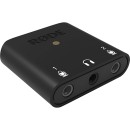
RODE AI-Micro |
VS | |
|---|---|---|
| 2 Inputs / 2 Outputs | Channels of I/O |
Analog: 2 Inputs / 2 Outputs at 192 kHz |
| 48 kHz / 24-Bit | Maximum Sampling Rate | 192 kHz / 24-Bit |
| 2 Preamps | Number of Microphone Inputs | 1 |
| 2x 1/8" / 3.5 mm TRRS Unbalanced Mic Input 1x 1/8" / 3.5 mm TRS Unbalanced Headphone Output |
Analog Audio I/O |
1x XLR 3-Pin Balanced Mic Input 1x 1/4" TS Unbalanced Line/Hi-Z Input (Front Panel) 2x 1/4" TRS Balanced Monitor Output 1x 1/4" TRS Headphone Output (Front Panel) |
| 1x USB-C (Class-Compliant) | Host Connection | 1x USB-C |
| macOS 11 Windows 10.19,041 14 9.0 |
OS Compatibility |
macOS Windows |
| USB Bus Power | Power Requirements | USB Bus Power, USB Power Adapter (Not Included) |
